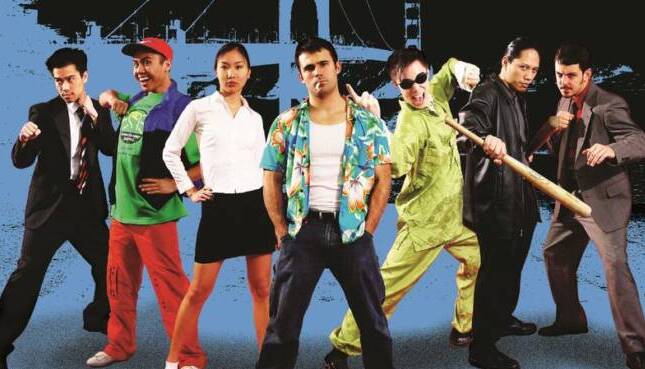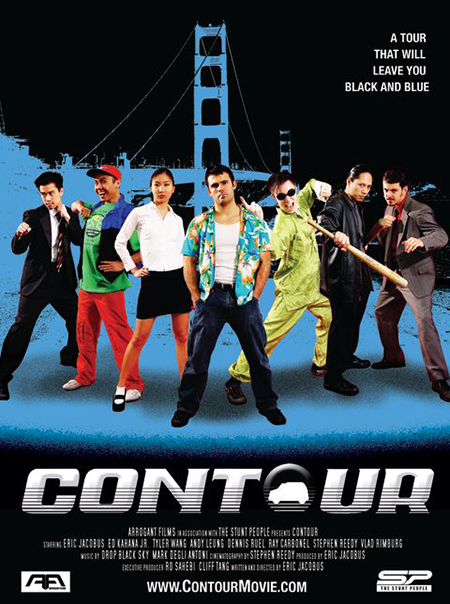Movies & TV / Columns
Eric Jacobus On His New Film Contour, Putting Together Fight Scenes
 Image Credit: Eric Jacobus
Image Credit: Eric Jacobus
The 411 Interview: Eric Jacobus

Eric Jacobus is a martial artist, stuntman, actor, writer, editor, and director who has been involved in movie making since at least 2001 when he formed The Stunt People with friends in California. Since then, Jacobus has starred in and collaborated on various short and feature films, including the Rope-A-Dope short film series, the Blindsided short films (check out my review of Blindsided: The Game here), and the feature film Death Grip, among others. His 2006 martial arts comedy Contour is set for a re-release and will be available for free streaming on the official Eric Jacobus YouTube page here starting April 19th, 2024 at 7pm PDT (10pm EDT). In this interview, Jacobus talks with this writer about making Contour, how difficult it was to make, and more.
**

Bryan Kristopowitz: How did Contour become your first solo feature film as a director?
Eric Jacobus: Actually we had started shooting a feature the summer before this called Immortal on lower-end tech, which took longer because of the visual effects requirements and was released later, so Contour was technically my second feature. I wrote a 40-page script about a conman tour guide, inspired by a 3-second moment in a short we had done that summer called Undercut. I took that to a friend who was starting a production company, acquired $3000, and that got us started.
BK: How did you approach your character Lawrence “Law” Young?
EJ: He’s a jaded worker living in San Francisco. I suppose I drew from my own experiences: I had come from a small town in northern California to attend school in San Francisco, and I had always considered the city some kind of mecca, but you realize that people are as dumb there as anywhere. There’s hick dumb, and then there’s city dumb. I felt like I knew them both pretty well by then, and imagined a character who could take advantage of that world, so I just played off that.
BK: Where was Contour made? How did you get access to that warehouse?
EJ: The exterior scenes are mostly shot in San Francisco. We stole every location. At one point I was so guerrilla in a shot that my van almost got hit by a cable car. Some shots were done in my home town of Redding, CA. My Taekwondo instructor Hugh Lau offered his Chinese medicine warehouse in Oakland as a location, probably not realizing that we’d spend the entire year there! Thanks Hugh (if you’re reading this)!
BK: How did you cast Contour?
EJ: In movies of this scale, whoever’s crazy enough to go along for the ride is your main cast. It was as simple as that. I was dating the main actress playing Renee at the time (a typical, young filmmaker story right there); Lei was played by Andy, my other Taekwondo teacher; Alfonso was played by Ed who I met in a Shaolin class at SFSU; the villains were Dennis, Ray, and Troy who were local indie filmmakers; Steve Reedy was the director of Undercut who agreed to make a total mockery of half his ethnicity (ha!); the rest were friends, family, other Stunt People members.
BK: How did the animated/manga inspired opening titles sequence come about? Was it something that you always wanted to have for the opening titles sequence or was it something you decided you wanted once you finished filming?
EJ: I was inspired by the Pink Panther films which always featured a fun animated introduction. Ed Kahana (one of the leads) was an amazing artist and spent a year doing it in Photoshop and After Effects. He actually tore his ACL early in production (due to a Wushu accident, not while shooting) so while he healed he hacked away at that. It’s still amazing to watch.
BK: How difficult was it to both star in and direct Contour?
EJ: It didn’t really occur to me. The best thing you can do as a director-star is tell everyone where you want to go, give them the best image of what that looks like, and pray they get it. There was one thing that always helped set the tone: I’d edit every evening and bring the new cut of the action scene to the crew the next day, and we’d watch it before rolling camera. That got everyone psyched. We really knew what to do after that. I think we hit our maximum flow state during Alfonso’s finale with the chain, which was 2 weeks of shooting, and it was a constant stream of ideas. I think that’s why that scene always gets the applause.
BK: What was the hardest part of making Contour for you, as both a director and actor? What was the easiest?
EJ: The hardest part was all of us were just transitioning out of college, or moving out of our parents’ place. I remember Andy telling us near the end of production, “Hey guys, uh first, I’m getting married… and secondly, we’ve got a kid on the way!” Huge shifts in life happening. It was sort of the last honeymoon before we all had to become adults. So nothing was certain. We were all wondering if the latest injury would make getting a job more difficult. I was also producing the project myself which meant scheduling everything, getting contracts, releases, and all that stuff. Everything was unpredictable, too. There were days when we’d show up at the warehouse and the entire place had been reorganized, or the workers had taped the area off so they could work there, so we’d have to find an excuse to move to a new aisle or room. We just did whatever we had to do to get the thing done.

BK: How long did it take to make Contour, from finishing the script to completing post-production?
EJ: I wrote the script pretty quickly, I think it took me 2 weeks. That was in October 2004. We were shooting in December. Ed got injured in Wushu early on, which delayed a lot of things. I think we shot for most of 2005 and finally got to his fight in October, and then shot the final scene in Donovan’s apartment (he plays the dojo owner who shows up at the end and causes hell), probably around November. We really trashed the place, broke the rail on the stairway, total mayhem. I had the film mostly edited by the time we finished shooting, since I was always editing dailies. My hard drive crashed, but I recovered everything and finished the edit mid-2006. I sourced music from like 10 different people, one guy doing part of the score refused to take any money but (as you’d expect) he was totally uncommunicative and wouldn’t answer his phone, until he dropped the finished CD off at my apartment and I was like, “Welp, guess that’s done.” Got the mix done, put it on DVD and we were selling it at Comic-Con in 2007.
BK: How difficult was it to find the right balance between the martial arts fight sequences and the comedic moments inherent in the characters and plot for Contour?
EJ: That comes second nature, but you have to have the right vibe with your crew. Everyone needs to be excited to lend to the humor. Naturally, you have to craft which direction the humor has to go. Michael Jai White said that when doing the comedy in Black Dynamite he had to really steer the ship hard at the beginning, but then everyone realized what they were making, and that movie’s legendary as a result. It’s a language you have to be able to speak with your crew, eventually everyone figures out how they can build on that.
BK: Contour is filled with plenty of great, hard hitting fight scenes. What fight was the hardest to put together and film? What was the worst injury suffered by a performer while filming?
EJ: The toughest fight was probably Andy’s finale. We were juggling Vlad’s schedule, Vlad dislocated his shoulder (it’s in the outtakes), Andy showed up with a buzz cut suddenly one day and I freaked out (not that anyone ever noticed), and Ray took a nasty kick that made him go numb for a while. Lots of big mistakes, but that fight’s one of my favorites.
BK: How has your fight choreography process changed since you started making movies?
EJ: Contour‘s action was all about vectors, shapes, and timing. It’s like when you first figure out how to draw comics you just wanna make the most dynamic poses possible, and you just fit the story to that. The choreography is all stream of consciousness, nothing was ever planned, which is sort of how fights actually feel. Nobody would have pre-planned the kind of fight Dennis and I did at the end: we literally just spent 14 days in warehouse aisles fighting, and some days we’d get almost nowhere and that was totally cool. The tie stuff is super-intricate and all stream of consciousness, too.
I make action differently today, but I still try not to over-plan action scenes. If you over-plan, sure your fight has the “Save-the-Cat” beats, but you lose the stream of consciousness. It’s fine to make a crazy wave of energy and just take people with you, I think we did that without even thinking about it. I still like the idea of obsessing over minute moments, like the beginning of Ed’s fight is all these weird kung fu shapes. Like, why?! Why are these random thugs doing crane kung fu? Who gives a sh*t? Half of Ed’s scenes are hallucinations anyway. I think we were just riding the wave at that point.
BK: Is the Contour that’s being released now any different than the Contour that was originally released back in 2006?
EJ: Now it’s been uprezzed to 4k, enjoy the crispy resolution! The edit should be the same.
BK: Any upcoming projects you can tell us about?
EJ: We’re working on an animated feature action comedy musical called Violent Rhythm and we’ll release the teaser soon. I’m also writing a book tentatively called The Art of Violence or The Thermodynamics of Violence and Language – A Stuntman’s Odyssey.

BK: What do you hope audiences get out of Contour?
EJ: I want them to have a good time. I want them to see how easy it was for 8 guys and a gal to go out there with a camera and make a feature film. Shoot your movie!
BK: What do you think Law is doing now? Do you think he’s still doing van tours of San Francisco and picking up “extra money” with side jobs or is he doing something else?
EJ: He’s probably got a kid or two by now, that’d be a fun story to tell.
BK: Where did you get that sweet portable phone from? Do you still have it?
EJ: It’s part of my daily carry.

**
A very special thanks to Eric Jacobus for agreeing to participate in this interview and to david j. moore for setting it up.
Contour will be available for free streaming on the official Eric Jacobus YouTube page here starting April 19th, 2024 at 7pm PDT (10pm EDT)
Check out my review of Contour here!
Check out the official Eric Jacobus website here!
Check out the Eric Jacobus imdb page here!
All images courtesy of Eric Jacobus.







